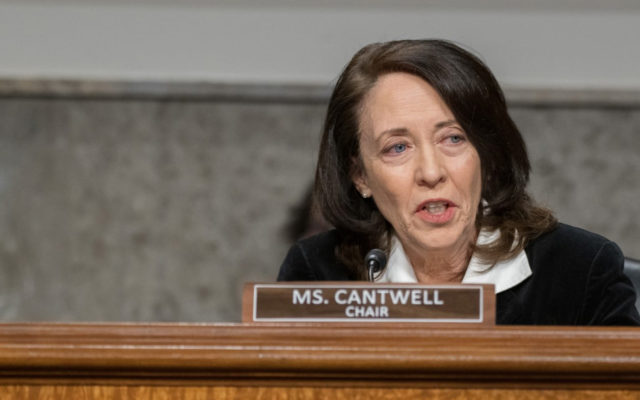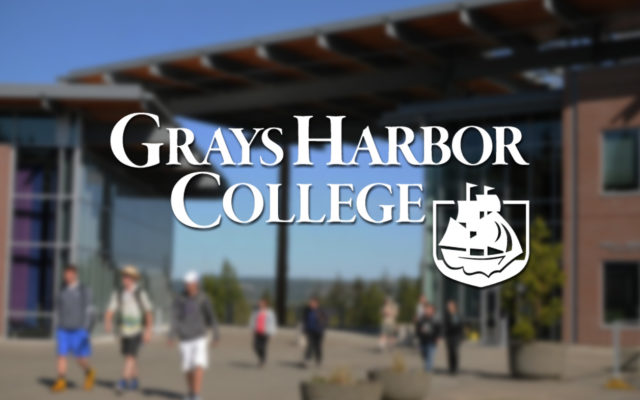Senator Cantwell shares local funding from $550 billion infrastructure bill

U.S. Senator Maria Cantwell (D-WA) applauded the House passage of the $550 billion Infrastructure Investment and Jobs Act (IIJA), which will provide investments in Washington state and the nation’s critical infrastructure.
The bill is expected to be signed by President Biden shortly.
The legislation, which contains numerous provisions authored and championed by Cantwell, includes boosts for transportation and water infrastructure projects all across the state, as well as dozens of measures to advance salmon recovery, restore Puget Sound’s ecosystem, combat wildfires and climate change, and fortify our electric grid.
“Infrastructure investment at last,” said Senator Cantwell. “This level of investment is long overdue, especially for a high-growth area like Puget Sound. It’s critical for keeping people and products moving. King County Metro will get $559 million to help it continue to electrify its fleet and expand service, Sound Transit will get more than $380 million as it works to deliver light rail to Everett and Tacoma, and airports across the state will get a total of more than $385 million to support our growing aviation sector. For the first time ever, there will be a dedicated grant program that local communities can access to address dangerous and costly at-grade crossing delays, which are common across the state. The State of Washington benefits from a flourishing trade economy, and the investments in freight infrastructure will help us stay competitive internationally. This legislation is going to create jobs and improve our state.”
As part of the infrastructure bill, $15 billion was allocated for airport infrastructure grants, similar to traditional Airport Improvement Program (AIP) funds.
The bill provides a projected $384.7 million in airport infrastructure grants to Washington airports.
This includes local funding.
| Airport Name | City | Total over 5 Years |
| Bowerman | Hoquiam | 1,480,000.00 |
| Ocean Shores Municipal | Ocean Shores | 550,000.00 |
The top Washington recipients include:
- Seattle-Tacoma International (SEA) ($228 million)
- Spokane International (GEG) ($32 million)
- Tri-Cities (PSC) ($16.7 million)
- Snohomish County (Paine Field) (PAE) ($16 million)
- Bellingham International (BLI) ($13.7 million)
- Boeing Field/King County International (BFI) ($6.8 million)
- Pullman/Moscow Regional (PUW) ($5.2 million)
- Yakima Air Terminal/McAllister Field (YKM) ($5.2 million)
- Pangborn Memorial Wenatchee (EAT) ($5.2 million)
- Walla Walla Regional (ALW) ($5.1 million)
- Friday Harbor (FHR) ($5 million)
Airports would have the flexibility to use funds not only for projects like runways, but for broader needs like terminal and gate construction, multi-modal projects, and low-emission ground service vehicles.
The full list of projected airport recipients can be found HERE.
In addition to airport funding, Cantwell shared a breakdown of funding throughout the bill.
The Infrastructure Investment and Jobs Act includes the following new investments that will impact Washington state (funding authorization is over five years unless otherwise noted):
Transportation Infrastructure —
- Megaprojects Grant Program: Authored by Senator Cantwell, this program will dedicate $5 billion in funding to support projects that are critical to our economy, but too large or complex for existing funding programs.
- Washington faces a significant need to help fund these kinds of projects, such as the I-5 Bridge Replacement Project in Vancouver and the U.S. 2 Trestle Replacement in Everett.
- Infrastructure for Rebuilding America (INFRA) Grant Program: This program, created by Senator Cantwell in the FAST Act of 2015, provides financial support to nationally and regionally significant freight and highway projects. $8 billion will be allocated to the INFRA Grant Program, which increases the program’s funding by 78%.
- Since the program’s creation in 2015, the State of Washington has been awarded over $243.8 million.
Passenger and Freight Rail:
- $3 billion for a new Cantwell-led highway-rail grade crossing elimination grant program, the first-ever dedicated grant program that local communities can access to address dangerous and costly at-grade crossing delays. The 50 most congested crossings in Washington are blocked for an average of two hours per day, with an average of 49 trains and 12,000 rail cars.
- $5 billion for Consolidated Rail Infrastructure and Safety Improvements Program (CRISI) grants, which will help improve the efficiency of Washington’s 23 short-line railroads, a critical link connecting Washington agricultural products to markets overseas.
- $12 billion for the Federal Railroad Administration (FRA) to expand the U.S. passenger rail network through multi-year planning and construction grants. This could support Washington State Department of Transportation’s (WSDOT) efforts to expand the Amtrak Cascades service, construct a new East-West Intercity Passenger Rail System, or study future viable routes that could improve rail service in Eastern Washington.
- $16 billion for Amtrak’s National Network to address the state of good repair backlog, including replacing Amtrak’s aging passenger cars used on the Empire Builder and Coast Starlight routes with safer and more comfortable cars.
- The bill also requires the Surface Transportation Board to hire additional staff to enforce Amtrak’s preference rights to ensure freight railroads allow Amtrak trains to run on time.
- $5 billion for Terminal Development Discretionary Grants. Washington airports will be eligible to compete for these grants. Building new airport terminals expands capacity, improves customer experience, and creates jobs.
- $5 billion to upgrade Federal Aviation Administration (FAA) air traffic control facilities. $200 million is reserved for FAA-owned contract towers.
Transit: This funding will greatly benefit transit agencies by helping to address their maintenance backlogs, capital needs, and electrification of their fleets. For example, the funding provided to Sound Transit could help the agency keep its light rail expansion projects to Everett and Tacoma on track. $89.9 billion has been allocated in the bill to improve transit for millions of Americans.
- $39.15 billion in new funding for public transit, including $1.79 billion for Washington.
- $4.75 billion for state of good repair grants to support maintenance, replacement, and rehabilitation projects.
- $8 billion for the Capital Investment Grant program, which has funded large transit projects like Sound Transit’s Link Light Rail and its extensions to Lynnwood, Federal Way, and the Eastside.
- $5.25 billion for the Low-No Emission Grant program to provide funding for projects replacing old buses with zero-emission and low-emission buses.
Roads and Bridges: Washington will receive an estimated $4.7 billion in formula highway funding and $605 million for bridge replacement and repairs. There are 416 bridges and over 5,489 miles of highway in Washington rated as being in “poor” condition. There is an additional $12.5 billion for a competitive bridge repair program.
Port Infrastructure Development Grant Program: The bill provides $2.25 billion for competitive grants to improve facilities, operations and intermodal connections to coastal seaports, river and Great Lakes ports. Funds will support projects to decarbonize port infrastructure, improve movement of goods through our nation’s ports, support decarbonization, and enhance port resiliency in the face of climate change.
Marine Highway Program (MARAD): The bill includes $25 million in funding to improve utilization of the 26 “Marine Highway Routes” which provide relief to landside corridors suffering from severe traffic congestion, air emissions or other environmental challenges.
Electric Vehicle (EV) charging network: The transportation sector is the most significant source of emissions in Washington state. Under the IIJA, Washington is estimated to receive $71 million to expand the EV charging network.
Strengthening Mobility and Revolutionizing Transportation (SMART) Grant Program: The bill provides $500 million in funding to states, cities, and localities to pursue smart transportation projects that increase transportation efficiency and safety, and will advance connected vehicles, intelligent transportation systems integration, and support technological transportation advancements in communities nationwide.
Rebuilding America’s Infrastructure with Sustainability and Equity (RAISE) Grant Program: Formerly called BUILD, this grant program supports small to mid-sized infrastructure projects that benefit local and regional economies. Though this program has been appropriated since 2009, this is the first time the program has been authorized. $7.5 billion will be allocated to this grant program, increasing the funding over prior levels by 50%.
Since its creation in 2009, Washington state has been awarded over $309.1 million from the program.
This additional funding could help support projects like Seattle’s $43 million East Marginal Way Corridor Improvement Project to facilitate freight mobility to the Port of Seattle and the Pines/Barker Road project in Spokane Valley. Culverts will also be eligible for this funding for the first time.
Puget Sound and Salmon Recovery –
“The infrastructure bill makes serious investments in some of our salmon recovery challenges. For the first time, the bill creates a new culvert removal and habitat restoration grant program that prioritizes salmon and will open up spawning habitat. The bill also provides robust funding for EPA regional efforts to clean up Puget Sound as well as a significant down payment in the Pacific Coastal Salmon Recovery Fund,” Senator Cantwell said following the Senate passage of the bill in August.
National Culvert Removal, Replacement and Restoration Grant Program: $1 billion for the U.S. Department of Transportation to create a new program aimed to remove, replace or restore culverts, which will enable the recovery of salmon passage and habitats. This provision was authored by Senator Cantwell, and this program will be the first federal program devoted entirely to culverts. In August, Senator Cantwell toured a culvert site at Carkeek Park in Seattle, WA to celebrate the inclusion of this program in the Infrastructure Investment and Jobs Act (IIJA) passed by the Senate.
Pacific Coastal Salmon Recovery Fund: $172 million for NOAA’s Pacific Coastal Salmon Recovery Fund, a grants program that provides funding to States and Tribes to protect, conserve, and restore West Coast salmon.
Fish Passage Barrier Removal Grants: $400 million for the creation of a new community-based restoration program focused on removing fish passage barriers
EPA Estuary Programs: The National Estuary Program (NEP) is a network of organizations that protects and restores 28 estuaries around the country, including the Puget Sound and Columbia River Basin.
- $89 million for the Puget Sound Geographic Program
- $79 million for the Columbia River Basin Geographic Program
- $132 million for the National Estuary Program
National Estuarine Research Reserves System Program (NERRS): The bill provides $77 million provides funding for collaborative research within the NERRS network of 29 coastal sites designated to protect and study estuarine systems.
NOAA Habitat Restoration Programs: Funds will be used to enable communities, Tribes, and states to respond and adapt to climate change impacts.
- $491 million for Habitat Restoration and Community Resilience Grants
- $492 million for the National Ocean and Coastal Security Fund Grants, a funding increase of $458 million
Coastal Zone Enhancement Technical Assistance and Grants: The bill includes $207 million in funding to increase technical assistance and grants to coastal state to advance projects that address wetlands, coastal hazards, public access, marine debris, cumulative and secondary impacts, special area management plans, ocean and Great Lakes resources, energy and government facility siting, and aquaculture.
Regional Ocean Partnerships (ROPs): The bill includes $56 million to allow ROPs to coordinate interstate and intertribal management of ocean, Great Lakes, and coastal resources, including set-asides to enhance Tribal participation and engagement.
Coastal, Ocean, and Great Lakes Observing Systems: There is $150 million included to upgrade the nation’s buoy and ocean observation network, including installation and implementation of high-frequency radar systems, underwater gliders to detect harmful algal blooms, and ensure safe navigation.
Marine Debris Assessment, Mitigation, and Removal: There is $200 million for the NOAA Marine Debris Program which provides grants for removal, habitat restoration, emergency response and research to address trash and pollution in the ocean.
Sport Fish and Recreational Boating Safety Trust Fund: The IIJA includes reauthorization of the Trust Fund which supports about $650 million annually to state fish and wildlife agencies to fund fishery restoration and conservation programs, boating access and infrastructure, as well as fish stocking programs important to recreational anglers.
Drinking Water & Wastewater Programs: These provisions of the IIJA help improve overall water quality and prevent pollution to protect salmon-supporting ecosystems. It also includes significant funding for Tribal and rural water systems and would provide funding for stormwater and wastewater systems in Washington state and Puget Sound.
- $23.4 billion for the bipartisan Drinking Water and Wastewater Infrastructure Act
- $10 billion across multiple programs for monitoring and remediation of perfluoroalkyl and polyfluoroalkyl substances (PFAS). These chemicals enter the environment through production or waste streams and are extremely difficult to remove. According to the EPA, PFAS chemicals are known have “adverse reproductive, developmental and immunological effects in animals and humans.”
Combatting Climate Change and Wildfires –
“It is so critical that money was included in the infrastructure package to help reduce fire risks because that’s something that’s going to plague us into the future. This infrastructure package helps reduce fire risk by doing things like mechanical thinning, controlled burns and collaboratives so that we can help try to prevent fires from starting, or having them gain so much fuel,” said Senator Cantwell regarding the infrastructure package in August.
Wildfire Risk Reduction: Senator Cantwell helped secure this funding which provides $3.4 billion to both the Department of Interior (DOI) and the Department of Agriculture’s U.S. Forest Service (USFS) to support a variety of wildland fire fighting efforts, like funding for community wildfire defense grants, mechanical thinning, controlled burns, the Collaborative Forest Landscape Restoration program, and firefighting resources.
Hazardous Fuels: Reduction of hazardous fuels generally requires the removing surface and “ladder” fuels like brush, small trees, and other vegetation that when accumulated can cause fires to burn hotter and grow faster. $1.138 billion in total funding for hazardous fuel reduction has been included in the bill.
- $35.6 million for DOI to carry out hazardous fuels reduction projects, including $10 million for Tribal Forestry Protection Act projects
- $102.8 million for USFS to carry out hazardous fuels reduction projects, with $40 million for Tribal Forestry Protection Act projects
- $1 billion for USFS to carry out State and Private Forestry grants for hazardous fuels work.
Burned Area Rehabilitation Programs: When fires burn so hot that they destroy a landscape beyond what can be naturally tolerated, some environments become unlikely to recover without human assistance. These programs repair or improve such landscapes. $500 million in funding for these programs has been included.
- $225 million over 5 years for DOI to carry out burned area rehabilitation
- $225 million over 5 years for USFS to carry out burned area rehabilitation
NOAA Fire Weather: This investment will support the further expansion and development of NOAA’s fire weather activities through the upgrade and replacement of data collection systems, enhanced modeling for better forecasts and hazard prediction, and improved tools that support land management agencies and emergency managers. $100 million in funding has been included for this program.
NOAA High Performance Computing (HPC): This funding will allow NOAA to increase computing capacity for forecasts and drought. In the next five years, NOAA will require more than 32-times the processing power than it has today, in large part to meet the increasing need for climate-related modeling (such as drought and precipitation), prediction, and forecast needs which have a direct impact on American lives and property. This will directly benefit Washington and other western states that are experiencing more extreme drought conditions, which in turn produce worsening fire seasons. $80 million in funding has been included for this program.
NOAA Flood Mapping, Forecasting, and Water Modeling: These funds will support NOAA’s inland flood mapping program, and provide resources to improve forecasting and flood modeling capabilities which will help with planning and the protection of lives and property. Flooding is Washington state’s most costly and reoccurring natural disaster. In general, cleanup costs following a flood are estimated to cost as much as three times more than the investment necessary to mitigate and prevent flood damage. This funding supports the programs that allow for the planning and implementation of those prevention measures by communities and states. $492 million in funding has been included for this program.
Fire Detection and Monitoring Equipment: $10 million for DOI and the Forest Service to implement wildfire detection and real-time monitoring equipment in areas at risk of wildfire or post-burn areas.
Satellite Program for Fire Detection and Reporting: $20 million for DOI and the Forest Service to work with NOAA to create a program that uses the Geostationary Operational Environmental Satellite Program to rapidly detect and report wild fire starts.
Water and Energy Infrastructure —
Western Water Infrastructure: The bill includes $8.3 billion to address historic droughts across the United States and restore aging water and irrigation infrastructure by funding water recycling and reuse projects; desalination projects; rural water projects; dam safety projects; drought remediation; and habitat restoration. The legislation would also boost groundwater storage and conveyance projects, including those like the Yakima Basin Integrated Plan and Odessa Groundwater Replacement Program. It also includes an amendment authored by Senator Cantwell to create a new program within the DOI to provide federal financial and technical assistance for groundwater recharge, aquifer storage and recovery, and water source substitution for aquifer protection projects.
Grid Infrastructure and Reliability: The legislation makes historic investments to make our nation’s electricity grid more reliable, resilient, and able to integrate renewable energy sources to stand up to increasingly frequent and intense weather events. This includes $5 billion to establish a new DOE grant program to support activities that reduce the likelihood and impacts to the electric grid due to extreme weather, wildfire, and natural disaster and includes wildfires in the eligibility for the Stafford Act hazard mitigation program. Cantwell authored three significant transmission provisions that were incorporated into the final bill including:
- $2.5 billion to establish a new Transmission Facilitation Program that will support new transmission lines or upgrade existing lines by authorizing the DOE to buy a portion of the planned capacity which it may then sell after determining the project has financial viability
- $3 billion to restart a Smart Grid Investment Grant Program, first authored by Cantwell in 2007, that will boost private sector investment in a range of technologies needed to modernize our nation’s grid.
- $10 billion increase in borrowing authority for BPA to assist financing of the construction, acquisition, and replacement of certain parts of the Federal Columbia River Power System
-
- Energy Storage: The bill incorporates Cantwell’s Pacific Northwest Pumped Storage Hydro Development Act which will facilitate approval of the Banks Lake Pumped Storage Project.
- Energy Cybersecurity: Legislation tackling cybersecurity threats that Cantwell first authored in 2015 was included and funded in the package. In total, $350 million was allocated for a wide range of new programs to enhance grid security, including programs to develop advanced cybersecurity applications and technologies for the energy sector, enhance and test emergency response capabilities of DOE, and increase the functional preservation of electric grid operations in the face of threats and hazards. The package also includes $250 million for grants and technical assistance for utilities to detect, respond to, and recover from cybersecurity threats.
- Columbia River Treaty: Cantwell authored legislation that will help push for the modernization of the Columbia River Treaty and rebalance the payments sent by the Pacific Northwest to Canada.
- Approximately $1 billion to upgrade transmission capacity between Canada and the Western and Southern U.S., contingent on the establishment of a more equitable entitlement payment to British Columbia.
- $100 million to create a new program to rehabilitate and enhance water storage at the John Keys pumping station at the base of the Grand Coulee Dam.
- $10 million to determine ways to improve coordination of water and power flows between British Columbia and the Pacific Northwest which could save ratepayers tens of millions of dollars.
Broadband –
Washington state has an ambitious plan to ensure access to broadband to residents across the state and bridge the digital divide. The legislation provides $65 billion for grants to states for broadband access in rural and underserved communities, affordability for low-income families, and infrastructure including middle-mile. This includes:
- $42.5 billion for a new National Telecommunications and Information Administration (NTIA) grant program that will provide grants to states to deploy broadband.
- $14.2 billion to make permanent the Affordable Connectivity Benefit that will help ensure low-income families have access to reliable, high-speed internet.
- $1 billion to establish a “Middle Mile” grant program that will allow broadband providers, utilities, electric co-operatives, regional planning entities, non-profits, and others to receive grant funding for deployment of middle mile broadband infrastructure in order to get affordable high-speed internet to unserved areas.
- $2 billion for Tribal Broadband Connectivity Program grants for broadband deployment, digital inclusion, workforce development, telehealth, and distance learning.
- $2 billion for the Department of Agriculture to support broadband deployment in rural areas.
- $2.75 billion to establish two NTIA-administered grant programs to promote digital equity and inclusion, ensuring that all communities and community members have the tools necessary to take advantage of broadband connection.
Minority Business Development Agency (MBDA) —
- MBDA: The aim of this federal agency is to promote the growth and competitiveness of minority-owned businesses by providing access to capital, contracts and market opportunities. The infrastructure package includes Senator Cantwell’s legislation that expands and makes the program permanent for the first time. The bill authorizes $550 million to the agency, doubling its current funding. Cantwell introduced the legislation in April 2021.
Improving Coast Guard Infrastructure and Childcare Services –
- U.S. Coast Guard Infrastructure: This $309 million investment will address needed and long overdue repairs and new construction of Coast Guard owned housing, buildings, and piers across the country including bases and Coast Guard facilities in Washington, Alaska, California, Connecticut, Florida, Missouri, New Jersey, New York, North Carolina, Rhode Island, and Texas.
- U.S. Coast Guard Childcare Development Centers: There is also $120 million to build Coast Guard owned and operated childcare centers, which are critical to retention of women serving in the Coast Guard, and their families.
Improving Safety —
- $7 billion for National Highway Traffic Safety Administration (NHTSA) safety programs, research, and education to improve driver behavior and roadway safety.
- $5 billion for Federal Motor Carrier Safety Administration (FMCSA) commercial motor vehicle safety programs to help states address highway fatalities, combat human trafficking, and improve law enforcement training.
- $5 billion for a new Safe Streets for All program to help local governments carry out Vision Zero plans and other improvements to reduce crashes and fatalities, especially for cyclists and pedestrians.
- $750 million to modernize state and federal crash databases to enable better data sharing and research into motor vehicle crashes.
- $1 billion to the Pipeline and Hazardous Materials Safety Administration (PHMSA) for grants to community-owned utilities to replace outdated gas pipelines in order to reduce injuries and fatalities and prepare our infrastructure for cleaner fuels.
- $500 million authorized to improve first responder planning and training for hazardous material incidents.
- The bill also requires life-saving technology on new motor vehicles, including automatic emergency braking, lane departure warning, advanced drunk driving prevention technology, and other mandates to improve road safety.
The full text of IIJA is available HERE.
A section-by-section is available HERE.
Video from Senator Cantwell’s floor speech ahead of the IIJA Senate passage is available HERE.
More about Puget Sound and salmon recovery measures in the IIJA HERE.
More about local transit investments in the IIJA HERE.
More about support for wildfire response and recovery in the IIJA HERE.
You Might Also Like



